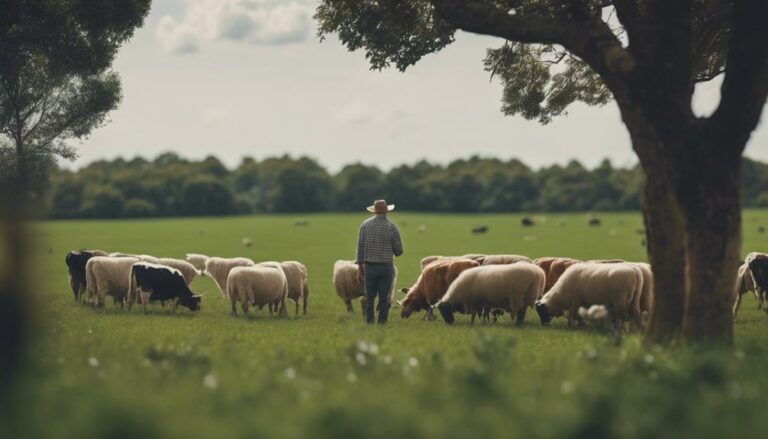Balancing the right stocking rates can be likened to walking a tightrope in the domain of livestock management. As you navigate through the myriad of factors influencing stocking rates, from soil quality to animal behavior, a critical question emerges: How do you strike that perfect equilibrium? The answer lies in a nuanced understanding of ecological dynamics and a keen eye for optimizing livestock production sustainably. Stay tuned to unravel the intricate strategies that hold the key to achieving the ideal stocking rates for your grazing operation.
Key Takeaways
- Utilize animal unit equivalents (AUEs) for accurate stocking rate calculations.
- Consider long-term forage production data to determine optimal stocking rates.
- Adjust stocking rates based on forage availability and ecological factors.
- Monitor standing crop data for informed decisions on stocking rates.
- Prevent overgrazing or understocking for sustainable livestock production.
Stocking Rates Calculation Methods
To accurately determine stocking rates, various calculation methods utilizing animal unit equivalents (AUEs) are essential for sustainable grazing management. State University research has shown that these methods play a significant role in determining the carrying capacity of a grazing area. By understanding the AUEs of different livestock species and their forage requirements, farmers can make informed decisions regarding stocking rates to optimize livestock production while maintaining forage quality.
State University research often utilizes tables and long-term forage production data to assist in accurately estimating stocking rates. These data provide valuable insights into the relationship between forage availability and animal numbers over time. By incorporating this information into their calculations, farmers can make sure that they aren't overgrazing their land, thereby promoting sustainable grazing practices.
Stocking Rates on Introduced Forages
Stocking rates on introduced forages demonstrate higher resilience to grazing pressure, allowing for increased grazing intensity to optimize forage utilization and ultimately maximize stocking rates. Introduced forages can handle close grazing but still need residue for health and productivity maintenance. These forages generally support higher stocking rates than rangeland types due to their ability to withstand grazing pressure. By adjusting grazing intensity, more available forage can be utilized efficiently, enhancing stocking rates per acre. Moisture availability plays a significant role in forage production on introduced forages, influencing decisions on stocking rates. Long-term forage production data and tables are valuable tools for estimating appropriate stocking rates for introduced forages. Utilizing these resources aids in making informed decisions to maximize stocking rates and optimize forage utilization effectively.
| Factors Influencing Stocking Rates on Introduced Forages | ||
|---|---|---|
| Resilience to grazing pressure | Increased grazing intensity | Peak forage utilization |
| Higher stocking rates per acre | Influence of moisture availability | Long-term forage production data |
Stocking Rates on Rangeland
Analyzing grazing intensity levels on rangeland is essential for maintaining plant vigor and preventing overgrazing. Rangeland stocking rates are typically lower than those for introduced forages due to the naturally lower forage production levels.
To avoid degradation, it's important to manage grazing intensity carefully. Factors such as soil depth, topography, and plant composition play significant roles in determining stocking rates on rangeland.
Monitoring standing crop data within grazing exclosures provides valuable insights for making informed decisions about stocking rates. Understanding the differences in forage production and utilization between rangeland and introduced forages is necessary for setting appropriate stocking rates.
Ecological Factors Impacting Stocking Rates
Ecological factors such as soil depth, topography, slope, and plant composition greatly impact the determination of stocking rates. These factors influence the availability of forage during the growing season, affecting the carrying capacity of the land. Soil depth plays a significant role as it affects root development and water retention, impacting plant growth. Topography and slope influence water distribution and nutrient availability, directly impacting vegetation productivity. Plant composition determines the quality and quantity of forage available to livestock. Variations in vegetation and forage production across different regions and years necessitate a dynamic approach to stocking rate decisions.
Understanding the interplay between these ecological factors is essential for sustainable grazing practices. Monitoring standing crop data within grazing exclosures provides valuable insights into forage availability and helps in determining appropriate stocking rates. By considering soil, climate, topography, and vegetation characteristics, managers can establish stocking rates that align with the carrying capacity of the land, ensuring efficient utilization of resources during the growing season.
Optimization Strategies for Stocking Rates
To optimize stocking rates effectively, one must carefully consider the intricate relationships between ecological site characteristics such as soil composition, climate patterns, and vegetation types. By understanding these factors, one can develop optimization strategies that maximize forage utilization and animal performance while maintaining ecological balance.
Monitoring standing crop data within grazing exclosures is essential for making informed decisions about stocking rates. Timely adjustments based on vegetation growth, utilization monitoring, and forage availability are key for sustainable livestock production. This proactive approach helps prevent issues such as overgrazing or understocking, ensuring the health of both the animals and the land.
While optimization strategies require attention to detail and continuous monitoring, they're essential for long-term success. By implementing these strategies, one can achieve the desired balance without the need for expensive interventions or costly consequences.
Conclusion
To wrap up, determining the right stocking rates is like finding the perfect rhythm in a complex dance between land, forage, and animals. By carefully considering factors like soil depth, topography, and plant composition, farmers can optimize their grazing areas for sustainable livestock production.
It's essential to monitor forage production data, adjust grazing intensity, and make timely adjustments to maintain the balance between forage utilization and animal performance remains harmonious. Striking this balance is vital for long-term success in livestock management.

